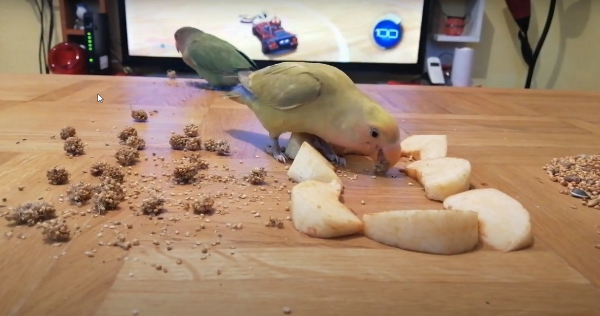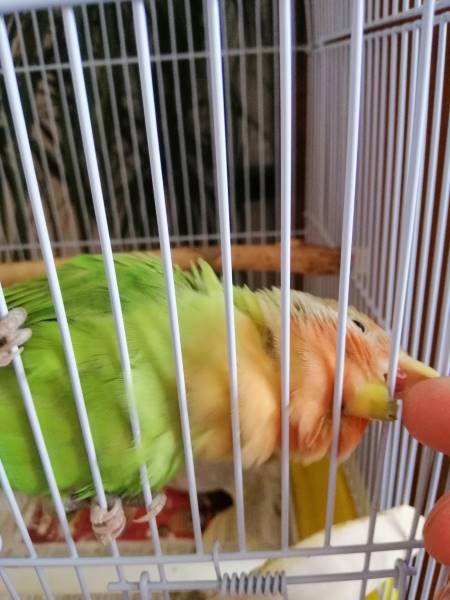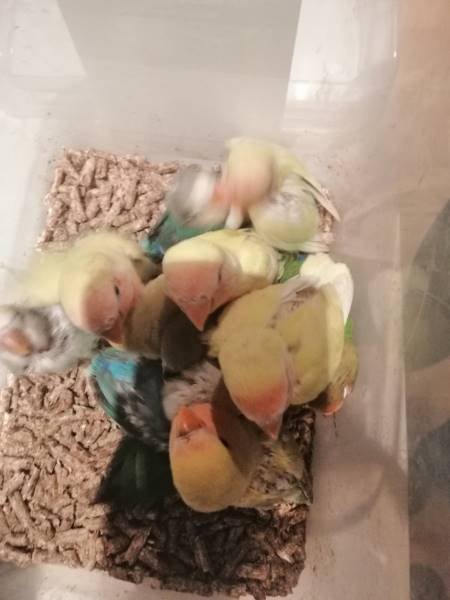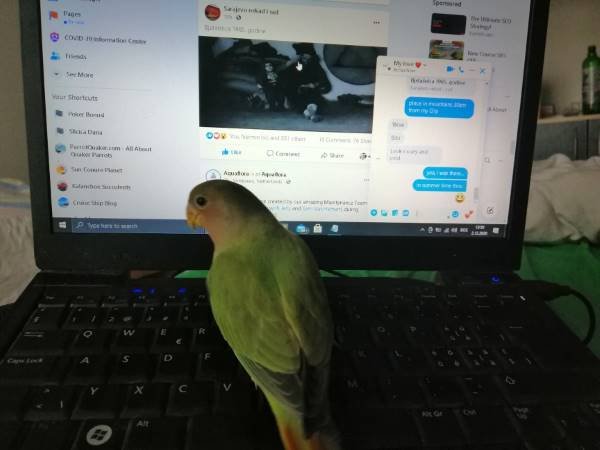Lovebirds are lovely creatures, but as cute as they are, they can only last long and stay healthy if the birds are managed appropriately. One of the significant problems you can face as an owner is when it’s time for them to breed. Most owners don’t know when the birds are ready and what to do when the lovebirds are prepared; that’s because readiness varies slightly with different lovebirds.
Fischer’s Lovebirds are easy to breed, unlike some certain birds. They produce their offspring efficiently when equipped rightly. Female lovebirds switch to breeding mode with the proper equipment, making it easy for the bird and the owner. For Fischer’s lovebirds to breed successfully, they must be healthy and mature enough for the process.
However, they exhibit different behaviors in this stage that can make it more confusing to their owners. However, it’s not much of a problem if you can understand how to help them during this period successfully.
How To Breed a Fischer’s Lovebird
If your lovebird is ready to breed, it is essential to know that they are called lovebirds for a particular reason: exhibiting romance. Like humans, lovebirds are romantic and care about their partners, which is where to start the process of breeding.
Getting the pair ready
The first thing to do as an owner is get the pair of lovebirds ready for mating, and it starts with determining the sex of the birds you already have. You might have to seek help from a vet because the male and female lovebirds look much alike. After you have the pair ready, allow them to stay together for a while to check the hen’s behavior because they sometimes reject the male, which is not suitable for breeding. However, if the pair stays together before then, you do not have to quarantine them.
Good diet for breeding
Feeding lovebirds with enough nutrients is essential to their overall well-being of the birds. Owners should not feed birds to stay alive alone; they should be fed to thrive and flourish. When a lovebird is adequately fed, they have immunity against health problems just like humans.

Lovebirds should be fed with nutritional diets, as their health is the most important thing to consider. Good seeds, pellets, fruits, and vegetables should be included in their diets, and they should be supplemented with vitamins and minerals. That is because these birds need energy derived from these nutrients at this time. Especially the egg-laying birds that lose calcium while laying eggs, their diet must contain enough calcium to replace the lost ones.
Nesting Requirements
To make the birds feel at home, they need a proper nest box to lay their eggs. And just as birds on a tree fill their nests with leaves, suitable nesting materials like shredded papers should be made available in the box. The reason is that female lovebird automatically switch to breeding mode once they see the nesting requirements are met.

You can always choose two different types of nest boxes for your lovebirds: The open-fronted nest box and the small hole nest box. However, the small hole nest box is the most suitable for Fischer’s lovebird.
Small hole nest box
This nest box should be made 12 inches high on every side and with an entrance hole that is 3 inches. The reason is that Fischer’s lovebirds are tiny in size, which will be perfect for the bird. The box should also accommodate two birds because, at this time, the male bird will not leave the female’s side throughout the breeding period.
Open-Fronted Nest Box
Certain birds such as Wrens, Pied Wagtails, and Robins prefer this nest. The blackbirds prefer the larger size of this box because of their size. It usually has the exact dimensions as the small hole nest box, but there is usually a larger square opening at the front, unlike the small hole box, which is round.
Possible Problems during breeding
As adorable as lovebirds are, especially when bonding, they sometimes have problems too. There is a need to know about problems the female lovebirds and baby lovebirds can encounter during breeding so that they won’t come as a surprise in the future. Some of these problems are:
Aggression
Lovebirds can be picky when selecting their mate. If they do not like the male, they may become aggressive towards the male. Lovebirds can become aggressive when they start to lay eggs. They may become over-protective of their eggs and become aggressive towards their owner or anyone who wants to come to their nest. The aggression occurs due to hormonal changes in its system. It is nothing to worry about as it will be over soon at the end of the stage.

Infertility
Infertile eggs can become annoying because if you are happy about breeding your lovebirds, you most likely want them to have healthy chicks. However, infertility is one of the significant problems that female lovebirds can encounter. Once the bird starts to lay its eggs seven or ten days after copulation, you can check for the egg fertility by picking up the egg to check for a membrane in the presence of bright light. Make sure you carefully handle the eggs as they are usually fragile during that time.
You can also prevent infertility by avoiding bad diets, inbreeding, and premature mating. The best option is to seek a veterinarian if you need more information.
Diseases and Death
During brooding, some chicks die in their shell and don’t ever get hatched. This is usually caused by temperature or genetic factors. In case of temperature, if the temperature is too high, the egg will be dehydrated. However, if there is insufficient humidity, the embryo may drown. Sometimes harmful organisms creep into the egg and cause the death of the embryo.
Sometimes chicks die during hatching. This is caused by insufficient humidity that hardens the eggshell. When the eggshells become hard, it becomes difficult for the chick to break out, and it becomes weak in the process, resulting in its death.
Also, if the absorption of the sac is delayed or there is premature handling, it can result in Omphalitis, a severe infection that can lead to death. Too much temperature, poor nutrition, and genetic factors can also cause deformity in chicks. Healthy chicks are usually active, and they respond to sound and movement. Once you discover pale and inactive chicks, it is a sign that there is a deformity in the chick.
Incubation
After the bird has laid its eggs, which varies with different birds, some lay up to five at a time, while some lay one egg every day until they are all laid. Love birds take about 23 to 25 days to incubate their eggs. When calculating hatch dates, always start counting forward on the exact date the bird begins to sit on the eggs. Sometimes some birds won’t sit until all the eggs of the clutch have been laid.
Male lovebirds, however, are found near the hen, they usually feed the hen during the brooding period, and maybe they also stay with them for companionship since they are lovebirds. During brooding, the hen only leaves the egg to excrete, drink, or eat. The rest of its time is spent sitting on the eggs.
After brooding, eggs are hatched. In some cases, some eggs hatch, while some don’t. Some hatch, but the chicks die within minutes of hatching. These are due to the some problems discussed above After hatching, check for the unhatched eggs and dead chicks to take them out. Provide enough nutritious food for the birds to help the hen recover its lost nutrients and help the chick develop properly. The hen feeds its chicks with the available food through its beak. The hen loves to feed its chicks with fresh and healthy foods, ensuring enough good nutrition for them. You can also try to hand feed them if you are experienced in doing so. This also helps the chicks to get familiar with you as their owner.
Fledging and leaving the nest
Chicks grow feathers as they develop in the nest. During this stage, they explore their nest, learning to fly, and after fledging, they are fed by the hen for another two weeks. After they are fully independent, you can take them out of the nest box to their cage. If they are not removed after independence, the mother might harm them. Some owners, however, give out their chicks to avoid overcrowding.

In general, lovebirds should be adequately cared for to prevent future problems. In the time of breeding, they need enough help and support from their owners to safely get through the stage and bring healthy chicks to life. To help the birds, it is important to learn about the breeding and necessary conditions for having a safe one. From getting the healthy right pair to watching the healthy chicks become independent, it all becomes easy when you know what to do.





Lovely, I would love to breed them….once I took breeding of rabbits and I was lucky to raise baby bunnies…..wow experience….in near future I will have Fischer’s yellow one….